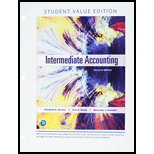
Concept explainers
a.
To calculate: The compensation cost to be recognized for the year.
Given Information:
Number of shares granted is 100,000.
Exercise price of the shares is $12.
Fair value at the grant date is $45.
Vesting period is 2 years.
Vesting probability is 100% in each year.
b.
The compensation expense for end of the year and journal entry of it.
Given Information:
Number of shares granted is 100,000.
Exercise price of the shares is $12.
Fair value at the grant date is $45.
Vesting period is 2 years.
Vesting probability is 100% in each year.
c.
The journal entry to record the actual exercise of stock option..
Given Information:
Number of shares granted is 100,000.
Exercise price of the shares is $12.
Fair value at the grant date is $45.
Vesting period is 2 years.
Vesting probability is 100% in each year.
d.
The value of compensation expense for the end of years and journal entry of it.
Given Information:
Number of shares granted is 100,000.
Exercise price of the shares is $12.
Fair value at the grant date is $45.
Vesting period is 2 years.
Vesting probability is 100% in first year.
Vesting probability is 80% in second year.
e.
The value of compensation expense for the end of years and journal entry of it.
Given Information:
Number of shares granted is 100,000.
Exercise price of the shares is $12.
Fair value at the grant date is $45.
Vesting period is 2 years.
Vesting probability is 100% in first year.
Vesting probability is 80% in second year.
Unexercised options expired rate is 25%.
Want to see the full answer?
Check out a sample textbook solution
Chapter 19 Solutions
Intermediate Accounting, Student Value Edition Plus MyLab Accounting with Pearson eText -- Access Card Package (2nd Edition)
- managerial accountingarrow_forwardi need correct optionarrow_forwardMark purchased 200 shares of stock for $40 per share. During the year, he received $500 in dividends. He recently sold the stock for $55 per share. What was Mark's return on the stock? a) $3,500 b) $4,000 c) $3,900 d) $4,500arrow_forward
- Summit Industries has a normal capacity of 30,000 direct labor hours. The company's variable costs are $42,000, and its fixed costs are $18,000 when running at normal capacity. What is the standard manufacturing overhead rate per unit? a) $1.50 b) $1.60 c) $2.00 d) $2.10arrow_forwardIvanhoe, Inc. has recently started the manufacture of Tri-Robo, a three-wheeled robot that can scan a home for fires and gas leaks and then transmit this information to a smartphone. The cost structure to manufacture 20,400 Tri-Robos is as follows. Cost Direct materials ($51 per robot) $1,040,400 Direct labor ($39 per robot) 795,600 Variable overhead ($7 per robot) 142,800 Allocated fixed overhead ($29 per robot) 591,600 Total $2,570,400 Ivanhoe is approached by Tienh Inc., which offers to make Tri-Robo for $116 per unit or $2,366,400. Following are independent assumptions. Assume that none of the fixed overhead can be avoided. However, if the robots are purchased from Tienh Inc., Ivanhoe can use the released productive resources to generate additional income of $375,000. (Enter negative amounts using either a negative sign preceding the number e.g. -45 or parentheses e.g. (45).) Direct materials Direct labor Variable overhead Fixed overhead Opportunity cost Purchase price Totals Make…arrow_forwardcorrect answer pleasearrow_forward
- cost accountingarrow_forwardSummit Holdings has $280,000 in accounts receivable that will be collected within 70 days. The company needs cash urgently and decides to factor them, receiving $260,000. Skyline Factoring Company, which took the receivables, collected $275,000 after 85 days. Find the rate of return on this investment for Skyline.arrow_forwardwhat are the variable expenses per unit?arrow_forward
 Intermediate Accounting: Reporting And AnalysisAccountingISBN:9781337788281Author:James M. Wahlen, Jefferson P. Jones, Donald PagachPublisher:Cengage Learning
Intermediate Accounting: Reporting And AnalysisAccountingISBN:9781337788281Author:James M. Wahlen, Jefferson P. Jones, Donald PagachPublisher:Cengage Learning

